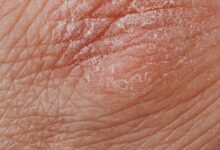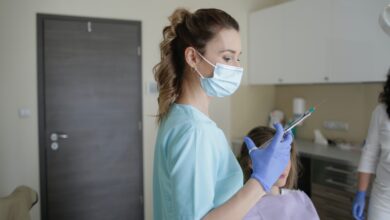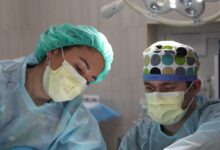
Vitiligo: treatments
There is no treatment that can cure vitiligo. However, current treatments make it possible to limit the size and number of depigmentation spots.
In children, doctors rarely resort to vigorous treatment and most often favor protection from the sun and camouflage with clothing.
Camouflage by cosmetics
Applying cosmetics to depigmented areas, such as specialized foundations (Dermacolor®, ColorTration®, Kamaflage® in Canada, Couvrance® Unifiance®, Covermark® in France) or self-tanning creams, helps to make the discoloration less apparent. of the skin, without however treating the disease.
Likewise, self-tanning creams can be helpful, as they work even in the absence of melanocytes. Cosmetics are especially helpful for people who have vitiligo patches around the eyes, where topical corticosteroids and UV light are contraindicated.
Repigmentation treatments
The objective of these treatments is to stimulate the multiplication of melanocytes still present in the skin. Dermatologists would be able to achieve repigmentation in several cases, especially if treated early. Repigmentation can be done by two processes: phototherapy or topical (local) treatments.
Topical treatments may be prescribed to repigment small spots of vitiligo. These creams reduce the activity of the immune system (including the autoimmune reaction), which has the effect of stopping the destruction of melanocytes. They must be applied once a day for several months. Unfortunately, they are not effective in all cases. Corticosteroid creams are often prescribed to be applied to recent spots.
Be careful not to exceed the number of prescribed applications, as this can lead to thinning (atrophy) of the skin. These creams are sometimes prescribed to children, with increased supervision. Topical immunomodulators, pimecrolimus (Elidel® in Canada) and tacrolimus (Prograf® in Canada, Protopic® in France) in cream, can also be applied to the spots. They only seem effective on localized spots on the neck and face .
Photochemotherapy by the method PUVA (combination of psoralen and UVA rays) consists in combining the exposure of the skin to UVA rays with the taking (orally, topically or in the form of a bath) of a substance called psoralen. Psoralen, ingested 2 to 3 hours before phototherapy, makes the skin more sensitive to ultraviolet rays. Oral psoralen is generally reserved for extensive forms of vitiligo (more than 20% of the body surface affected).
The treatment requires great diligence since it takes place in several sessions (from 100 to 300) at a rate of 1 to 3 times a week. You have to wait about 2 or 3 months (or 200 sessions) to obtain a visible effect. “PUVAtherapy” is quite effective, but total repigmentation is only obtained in 15% to 20% of people treated22. It can cause itching, pain, and a sunburn-like burn. In the long term, this treatment slightly increases the risk of skin cancer .
Contraindication: photochemotherapy is contraindicated for children under 12 and pregnant or breastfeeding women.
Narrow-spectrum UVB phototherapy is a newer method of phototherapy that does not require taking or applying psoralen, and is therefore simpler than PUVA photochemotherapy. It is based on exposure to ultraviolet B radiation which stimulates the repigmentation of dark spots. It is mainly intended for cases of extensive vitiligo and is especially effective on facial lesions.
Up to 3 sessions can be administered per week and there are fewer immediate side effects than with the PUVA method (less burning or pain). Doctors still lack perspective to compare UVB phototherapy to PUVAtherapy, but the first clinical trials have been very encouraging . This technique can even be offered to some children with very troublesome forms of vitiligo.
The use of the laser (308 nm excimer type) seems promising3, but there are still few clinical trials.
Depigmentation treatments
The goal here is to permanently depigment the entire skin to achieve an even appearance. This therapeutic option is quite radical and is only considered when vitiligo covers most of the body (vitiligo universalis). “Whitening” chemical solutions (eg Benoquin®) are applied every day for more than a year.
However, half of the people treated would suffer from side effects (redness and dryness of the skin, burns, etc.), and once the treatment is finished, exposure to the sun should be avoided as much as possible since the skin becomes strong there. sensitive.
Surgical treatments
In some cases, especially when the body hair and the hair itself are depigmented, skin grafts can be offered. These grafts are especially suitable for people with segmental vitiligo, that is to say, affecting only one part of the body and no longer evolving. These are autologous transplants, that is to say that the grafts are taken from the patient himself, in areas of the body that are not affected by vitiligo.
This makes it possible to avoid transplant rejection and the taking of immunosuppressive drugs. A new technique, melanocyte transplantation (or “melanocyte transplant”) makes it possible to recover melanocytes from healthy areas of skin and inject them into depigmented spots. Still experimental, this treatment is however not available everywhere.
Support group
Because it changes the appearance and often affects visible areas of the body, such as the hands, face and arms, vitiligo can cause discomfort and some embarrassment in front of others. Aesthetic damage can sometimes be the cause of real psychological distress, which should not be minimized and which must absolutely be taken care of. For people who feel the need to talk about this, support groups can provide important emotional support. Psychotherapy can also bring relief to some patients.














